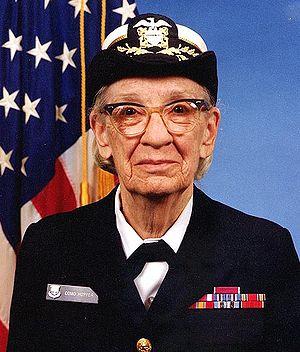Grace Murray Hopper (U.S. Navy Rear Admiral/Computer Scientist)
 Rear Admiral Grace Murray Hopper (December 9, 1906 – January 1, 1992) was an American computer scientist and United States Naval officer.
Rear Admiral Grace Murray Hopper (December 9, 1906 – January 1, 1992) was an American computer scientist and United States Naval officer.
A pioneer in the field, she was one of the first programmers of the Harvard Mark I computer, and she developed the first compiler for a computer programming language.
She conceptualized the idea of machine-independent programming languages, which led to the development of COBOL, one of the first modern programming languages.
She is also credited with popularizing the term "debugging" for fixing computer glitches (motivated by an actual moth removed from the computer). Because of the breadth of her accomplishments and her naval rank, she is sometimes referred to as "Amazing Grace". The U.S. Navy destroyer USS Hopper (DDG-70) was named for her.
Hopper was born Grace Brewster Murray in New York City. For her preparatory school education, she attended the Hartridge School in Plainfield, New Jersey. She applied for early admission to Vassar College at age 16, but was rejected (her test scores in Latin were too low); she was admitted the next year.
She graduated Phi Beta Kappa from Vassar College with a bachelor's degree in mathematics and physics in 1928 and pursued her graduate education at Yale University, where she received a Master's degree in those subjects in 1930.
In 1930, she married Vincent Foster Hopper (1906–1976), who was then (and for many years afterward) on the faculty of NYU. In 1934, she earned a Ph.D. in mathematics from Yale under the direction of Øystein Ore. Her dissertation, entitled New Types of Irreducibility Criteria, was published that same year.
Hopper began teaching mathematics at Vassar in 1931, and by 1941 she was an associate professor. She was divorced from Vincent Hopper in 1945. She kept his surname; she never remarried.
In 1943, Hopper obtained a leave of absence from Vassar and was sworn in to the United States Navy Reserve, one of many women to volunteer to serve in the WAVES. She had to get an exemption to enlist; she was 15 pounds below the Navy minimum weight of 120 pounds. She reported in December and trained at the Naval Reserve Midshipmen's School at Smith College in Northampton, Massachusetts.
Hopper graduated first in her class in 1944, and was assigned to the Bureau of Ships Computation Project at Harvard University as a Lieutenant, junior grade. She served on the Mark I computer programming staff headed by Howard H. Aiken. Hopper and Aiken coauthored three papers on the Mark I,II,II also known as the Automatic Sequence Controlled Calculator.
Hopper's request to transfer to the regular Navy at the end of the war was declined due to her age (38).
She continued to serve in the United States Navy Reserve. Hopper remained at the Harvard Computation Lab until 1949, turning down a full professorship at Vassar in favor of working as a research fellow under a Navy contract at Harvard.
Related Articles
- Ruth Benerito (Scientist)
- Mae Jemison On Teaching Arts And Sciences Together
- Barbara Block (Researcher/Scientist/Professor)
- Susan Solomon (Atmospheric Scientist/Led The National Ozone Expedition to Antarctica)
- Miwa Matreyek Creates Multi-Media Magic
- Jessa Gamble on The Science Behind Our Body Clock
- Johanna Blakley on Social Media and The End of Gender
- Pat Mitchell (Media Pioneer)
- AAA Alphabetical TED Women Talks List